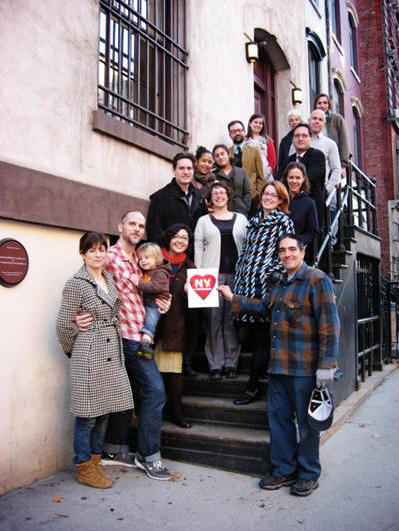Congratulations to the 2014 Excellence Award Winners
A community-led effort to give new life to a relic of the heyday of rail. A vibrant artistic hub in a building that was once on the brink of demolition. An all-volunteer preservation group that got its start supporting arts and culture. The restoration and interpretation of a contemporary artist’s live-work space in SoHo. These were just a few of the Award-winning projects and organizations honored by the Preservation League on May 14, 2014.
Altamont Free Library Train Station Renovation, Altamont
When it was built in 1897, the Delaware & Hudson Trains Station connected the people of Altamont with the wider world. When that same building reopened in 2012 as the Altamont Free Library, it served a similar purpose. The conversion took the effort of nearly 1,000 donors and volunteers, the support of local leaders, and a great deal of tenacity. Now, a historic structure that is integral to the Village’s history is providing an accessible home to the Altamont Library and improved library services to the community.
Academy Lofts, Albany
Located at a prominent corner in the Arbor Hill / Ten Broeck Triangle Historic district the former St. Joseph’s Academy once stood decaying in one of Albany’s most challenged neighborhoods. Now, in addition to providing 22 affordable apartments for artists, Academy Lofts encourages Arbor Hill residents and visitors to take pride in their historic district and fosters a stronger sense of community in the area. Further, the effort has provided a resource that will contribute to Arbor Hill becoming a neighborhood of choice.
Williamsburgh Savings Bank, Brooklyn
Completed in 1875 and deemed “One of the most monumental spaces surviving in New York from the Post-Civil War era” by New York’s Landmarks Preservation Commission, the Williamsburgh Savings Bank had been allowed to succumb to the effects of time and neglect until 2010. Through the vision of the new owners and the efforts of a team of skilled artisans, the building is once again an icon of an early New York neighborhood in its prime.
Holy Rosary Apartments, Rochester
At the time of its construction, the Holy Rosary Church in the Northwest neighborhood was described as an example of the Spanish Mission style, likely because of details such as the red tile roof, the Mujedar rose window and the arcaded pergola. But much as these elements – a blend of Christian and Moorish styles – created a house of worship that was more than the sum of its parts, so the redevelopment of the Holy Rosary complex of buildings has revitalized the community surrounding it.
New York City Hall Renovation, New York
Designed by John McComb and Joseph Francois Mangin, New York City Hall was built from 1803-1812 and has remained in continuous use since it opened. Well-intentioned but poorly-executed alterations over the years had compromised the historic integrity as well as the stability of the building. The restoration of public spaces, including the City Council Chamber, has restored a degree of grandeur for elected officials, staff and visitors alike. The project leaders placed a high value on the building’s history while bringing it up to modern standards and maintaining exemplary standards for historic preservation.
Donald Judd Home & Studio, New York
Built in 1870 and designed by Nicholas Whyte, the 5-story cast iron building in SoHo was purchased by the artist Donald Judd nearly a century later, in 1968. In addition to a painstaking restoration of the building’s exterior, the interior has been very carefully restored to the period when Judd lived and worked there. The project team’s efforts to deliver greater public accessibility while respecting the building’s historic, artistic and cultural significance are commendable.
Warburton Lofts at Philipse Manor Hall Historic District, Yonkers
This collection of late 19th to early 20th century “Main Street” commercial buildings presented a variety of preservation challenges to the developer: structural failures, unsound party walls, fire damage, asbestos, inappropriate alterations and pervasive neglect. But by following an important tenet of sustainability and reusing existing buildings, this collection of buildings now provides rich historic texture to the streetscape, as well as quality retail space, affordable housing, and represents another step it the right direction for Yonkers’ burgeoning historic core.
St. Mark’s Historic Landmark Fund in New York
Since its founding in 1975, the organization (first known as Friends of St. Mark’s) has literally brought two buildings back from the ashes. But in addition to saving and preserving historic St. Mark’s Church-in-the-Bowery, and the 1901 Rectory designed by Ernest Flagg, St. Mark’s Historic Landmark Fund has provided an essential community resource. With the opening of the Neighborhood Preservation Center in the restored Rectory in 1999, the group has brought together preservation groups from around New York City, New York State, and beyond. The Fund’s Neighborhood Preservation Center provides support and meeting space to both fledgling and established preservation organizations
By highlighting the best preservation projects in New York State, the League recognizes the dedication and skill of the advocates, architects and the craftspeople that make preservation happen.
These statewide awards also serve as case studies for neighborhood revitalization, adaptive use, building restoration and architectural excellence.
The Preservation League awards program is supported by a generous grant from the Arthur F. and Alice E. Adams Foundation.








